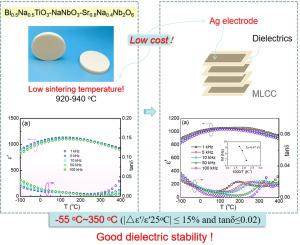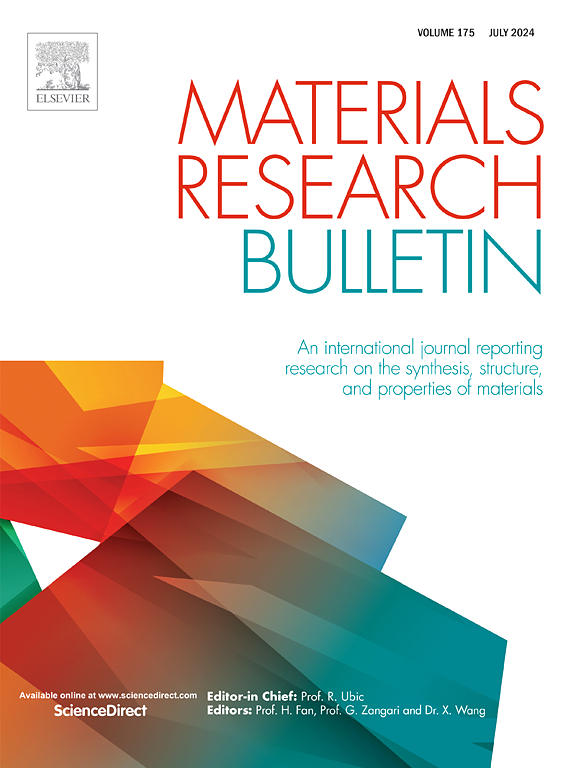低温共烧电容器陶瓷和含银内电极的 MLCC 器件的介电性能
IF 5.3
3区 材料科学
Q2 MATERIALS SCIENCE, MULTIDISCIPLINARY
引用次数: 0
摘要
成功制备了低温烧结 0.99((1-x)Bi0.5Na0.5TiO3-xNaNbO3)-0.01Sr0.8Na0.4Nb2O6 (100xNN, x = 0.25 和 0.30) 陶瓷和 MLCC,并系统研究了其介电性能。25NN 陶瓷在 25 °C 时的介电常数(ε′25 °C)为 1088,在 -88 °C 至 400 °C 之间介电变化很小(△ε′/ε′25 °C|≤15%,△ε′=ε′-ε′25 °C)。25NN 陶瓷的介电损耗正切(tanδ)在 -65 °C 至 358 °C 之间小于 0.02。使用 25NN 陶瓷电介质和 Ag 内电极的 MLCC 也具有极佳的介电稳定性,其中|△ε′/ε′25 °C| 在 -100 °C 至 400 °C 之间小于 15%,介电损耗在 -88 °C 至 373 °C 之间小于 0.02。所有这些结果表明,内电极为银的低温烧结 MLCC 在使用温度通常高于 300 ℃ 的汽车发动机和航空航天领域是一种很有前途的电容器。本文章由计算机程序翻译,如有差异,请以英文原文为准。

Dielectric properties of low-temperature co-fired capacitor ceramics and MLCC devices with Ag inner electrodes
Low-temperature sintered 0.99((1−x)Bi0.5Na0.5TiO3-xNaNbO3)-0.01Sr0.8Na0.4Nb2O6 (100xNN, x = 0.25 and 0.30) ceramics and MLCC were successfully prepared, and the dielectric properties were systematically investigated. The dielectric permittivity at 25 °C (ε′25 °C) of 25NN ceramic is 1088, and the dielectric variation is small between −88 °C and 400 °C (|△ε′/ε′25 °C| ≤ 15%, △ε′=ε′-ε′25 °C). The dielectric loss tangent (tanδ) of 25NN ceramic is less than 0.02 between -65 °C and 358 °C. The MLCC with 25NN ceramic dielectrics and Ag inner electrode also has excellent dielectric stability, of which |△ε′/ε′25 °C| is less than 15 % between −100 °C and 400 °C, and the dielectric loss is less than 0.02 between −88 °C and 373 °C. All these results indicate that the low-temperature sintered MLCC with Ag inner electrodes is a promising capacitor in automobile engines and aerospace fields, where the usage temperature is often above 300 °C.
求助全文
通过发布文献求助,成功后即可免费获取论文全文。
去求助
来源期刊

Materials Research Bulletin
工程技术-材料科学:综合
CiteScore
9.80
自引率
5.60%
发文量
372
审稿时长
42 days
期刊介绍:
Materials Research Bulletin is an international journal reporting high-impact research on processing-structure-property relationships in functional materials and nanomaterials with interesting electronic, magnetic, optical, thermal, mechanical or catalytic properties. Papers purely on thermodynamics or theoretical calculations (e.g., density functional theory) do not fall within the scope of the journal unless they also demonstrate a clear link to physical properties. Topics covered include functional materials (e.g., dielectrics, pyroelectrics, piezoelectrics, ferroelectrics, relaxors, thermoelectrics, etc.); electrochemistry and solid-state ionics (e.g., photovoltaics, batteries, sensors, and fuel cells); nanomaterials, graphene, and nanocomposites; luminescence and photocatalysis; crystal-structure and defect-structure analysis; novel electronics; non-crystalline solids; flexible electronics; protein-material interactions; and polymeric ion-exchange membranes.
 求助内容:
求助内容: 应助结果提醒方式:
应助结果提醒方式:


